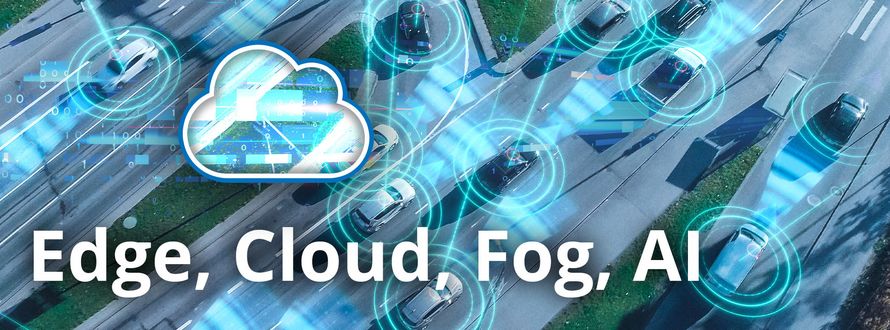Imagine a future where every vehicle is seamlessly integrated into a vast, intelligent network, harnessing the power of Edge Computing, Cloud Computing, Fog Computing, and Edge AI. This vision is increasingly becoming a reality in the automotive industry, driven by the need for more efficient, safe, and intelligent vehicles. But why is the automotive market eager to embrace the Cloud, and which components are most affected?
Vehicles today generate vast amounts of data, from engine performance metrics to driver behavior analytics. While Cloud Computing offers unparalleled processing power and storage capabilities, transferring all this data to the Cloud incurs significant costs for Original Equipment Manufacturers (OEMs). Hence, there's a strategic push to process and analyze data locally in the vehicle or at nearby nodes, filtering and sending only the most critical information to the Cloud. This approach minimizes costs while ensuring vehicles remain at the cutting edge of technology. This blog post is designed to demystify these technologies within the Edge-to-Cloud framework, focusing on their integration in the automotive industry. We'll explore how each component contributes to this ecosystem, examining both the hardware and technology perspectives.
The Edge-to-Cloud Framework in Automotive Tech
In the automotive industry, the Edge-to-Cloud approach is transforming how vehicles interact with each other and the environment. This integrated system ensures seamless data flow from local computing in the vehicle (Edge) to centralized Cloud-based analytics, with Fog Computing providing an intermediary processing layer.
1. Edge Computing in Vehicles
Hardware: Modern vehicles are equipped with a multitude of sensors, cameras, and onboard computers. These are the hardware foundations of Edge Computing in cars that exemplified an array of IoT devices. They include (sub)systems/modules like ECUs (Engine Control Units), GPUs for handling complex visual data, and specialized automotive chips designed for fast, local data processing.
PikeOS Integration: Integrating RTOS and hypervisor functionalities, technologies like PikeOS play a crucial role in automotive Edge Computing. An RTOS ensures that time-critical tasks, such as processing sensor data for emergency braking or lane-keeping, are executed reliably and within stringent time constraints. Concurrently, the hypervisor aspect of PikeOS allows multiple virtual machines to run on a single physical hardware platform, securely isolating critical automotive functions from less critical applications. This dual capability is essential for balancing the demanding performance and safety requirements of modern vehicles with the need for robust security and system stability.
Functionality: These components allow vehicles to process critical data in real-time. For example, sensors detect nearby obstacles, cameras provide real-time video feeds for driver assistance, and onboard computers make immediate decisions for autonomous actions like emergency braking or lane-keeping.
2. Fog Computing: The Connectivity Enabler
Hardware: Fog Computing in automotive systems often involves Roadside Units (RSUs) or local cellular towers equipped with processing capabilities. These units act as local data hubs, bridging the vehicle's Edge devices with broader network infrastructure.
PikeOS Integration: In the context of Fog Computing, the integration of RTOS and hypervisor technologies, such as those provided by PikeOS, is equally critical. An RTOS ensures that the data processing on RSUs or local cellular towers is timely and deterministic, crucial for applications that demand quick responses, like adjusting traffic flow or enhancing road safety based on real-time conditions. The hypervisor capability, meanwhile, offers a secure, isolated environment for running multiple applications on these RSUs, ensuring that critical safety functions are segregated from other data processing tasks. This segregation is vital for maintaining system integrity and preventing potential cyber threats from compromising vehicle safety and traffic management systems.
Functionality: RSUs can process data from multiple vehicles simultaneously, making quick decisions that affect traffic flow or road safety. For instance, they might aggregate data on traffic conditions and communicate adjustments to connected vehicles, reducing congestion and enhancing safety.
3. Cloud Computing: The analytical Backbone
Hardware: The Cloud aspect relies on expansive data centers equipped with high-capacity servers. These data centers are the central hubs for long-term data storage and in-depth analysis.
Functionality: Cloud servers collect vast amounts of data from vehicles across the network. This data is used for extensive analysis, like optimizing traffic patterns, improving vehicle design based on usage patterns, and developing new autonomous driving algorithms.
4. Edge AI: Intelligent Onboard Processing
Hardware: Edge AI in vehicles involves AI-capable chips and GPUs integrated into the vehicle's onboard computing system. These powerful processors are capable of running complex AI models.
Functionality: Edge AI enables advanced features like real-time object recognition, predictive maintenance, and autonomous decision-making. For example, AI algorithms process sensor data to identify and react to dynamic road conditions, enhancing safety and driving experience.
The big Picture: How it all comes together
In the automotive context, Edge-to-Cloud is a holistic approach where each component plays a crucial role. Edge Computing provides immediate, on-the-spot data processing. Fog Computing extends these capabilities, offering local processing and quick responsiveness over a broader area. Cloud Computing brings in the power of big data analytics, feeding back into the system to enhance overall performance and intelligence. Edge AI adds a layer of smart, autonomous decision-making at the local level.
Conclusion
The integration of Edge Computing, Fog Computing, Cloud Computing, and Edge AI in the automotive industry exemplifies the potential of the edge-to-cloud approach. It's a symphony of technologies where each instrument plays a vital role, harmonizing to create a safer, more efficient, and intelligent driving experience. This technological convergence is not just reshaping the automotive landscape; it's setting the stage for a future where smart, connected vehicles redefine mobility and road safety.
Find also more information at www.sysgo.com/edge-to-cloud

